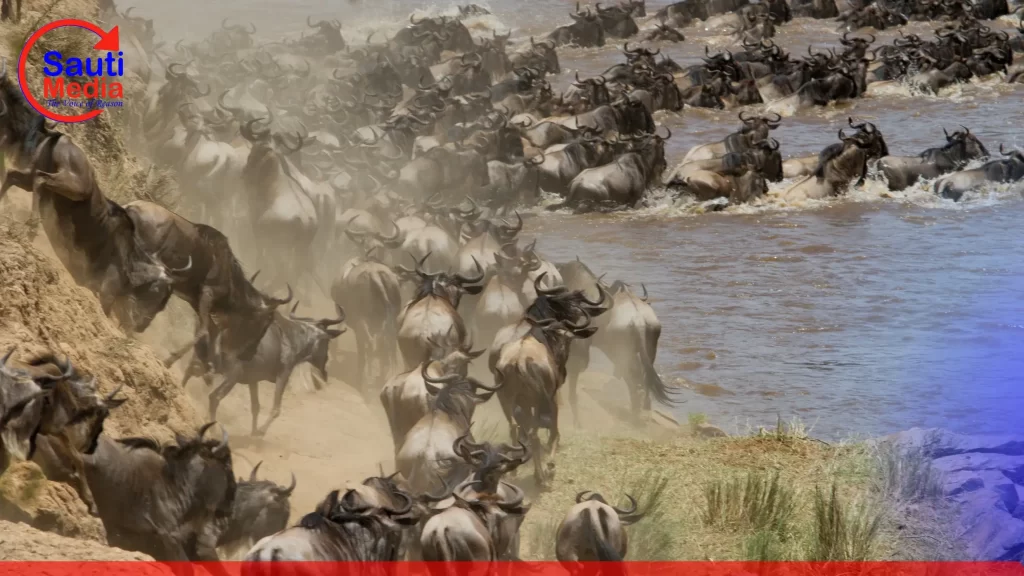The annual great wildebeest migration is one of the most awe-inspiring and extraordinary events in the animal kingdom. You can’t help but keep a calender of the amazing Wildebeests Migration. Over two million wildebeest, along with hundreds of thousands of zebras and gazelles, embark on a monumental journey across the vast savannas of the Serengeti and Masai Mara in search of greener pastures. Serengeti National Park is in Tanzania as Masai Mara national Park is in Kenya, both countries in East Africa.

The Cycle of the Great Migration
The Great wildebeest Migration follows a cyclical pattern, shaped by the changing seasons and the availability of resources. The journey is a continuous loop, with the herds moving in a circular motion through the Serengeti park in Tanzania and Kenya’s Masai Mara ecosystem.
Here is a deondable calender of the amazing Wildebeests Migration.
- Calving Season (January – March): The migration begins in the southern Serengeti during the calving season. This is a critical time for the wildebeest, as they give birth to their young. The vast grasslands provide nutrient-rich grazing, ensuring the survival of the newborns, while also attracting predators like lions and cheetahs in search of vulnerable prey.
- Grumeti River Crossing (May – July): As the dry season sets in, the herds start moving northward in search of water and fresh grazing. One of the most dramatic and perilous stages of the migration is the crossing of the Grumeti River. Here, the wildebeest must brave the treacherous currents and formidable crocodiles that lie in wait.
- Mara River Crossing (July – October): The pinnacle of the Great Migration is the Mara River crossing. As the herds arrive at the Mara River, they face another daunting challenge, this time on an even grander scale. With pounding hooves and sheer determination, they attempt to cross the river, creating a scene of spectacular chaos and raw survival. Predators, like hungry lions and opportunistic crocodiles, eagerly await this annual feast.
- Return to the South (November – December): Once the herds have crossed the Mara River and enjoyed the lush grasslands of the Masai Mara, they begin their journey back to the southern Serengeti, where the cycle will begin anew. The migration is a continuous cycle, ensuring the preservation of the ecosystem and the perpetuation of the species.
The Impact and Significance of the Great Migration
The Great Migration is not only a stunning spectacle but also plays a vital role in maintaining the delicate balance of the ecosystem. The constant movement of millions of animals helps rejuvenate the grasslands, preventing overgrazing and promoting biodiversity. The droppings of the migrating herds fertilize the soil, benefiting the growth of new vegetation and providing sustenance to a diverse range of herbivores and carnivores alike.
For local communities, the migration has deep cultural and economic significance. The Maasai people, in particular, have coexisted harmoniously with the wildlife for generations, and their traditions and way of life are intrinsically connected to the rhythms of the migration.
A Conservation Imperative
Preserving the Great Migration is a collective responsibility. Conservation efforts, both on a local and global scale, are essential to protect the habitat, wildlife, and migratory routes. Sustainable tourism practices that prioritize the welfare of the animals and the natural environment are crucial for ensuring that future generations can also bear witness to this breathtaking natural wonder.
The Great Migration is a once-in-a-lifetime opportunity to witness the power of nature. If you are a wildlife enthusiast or an adventure seeker, then you should definitely add this Calender of the amazing Wildebeests Migration to your bucket list. Kenya has many tour guides, hotels, and other facilities to make your trip as enjoyable and memorable as possible.
I hope you will consider visiting Kenya and witnessing this amazing natural phenomenon for yourself.



1 comment
[…] Nairobi Safari Walk: Embark on a thrilling 1.5 km walk through Nairobi National Park and encounter an array of fascinating wildlife, including majestic lions, graceful zebras, and towering giraffes. https://sautimedia.com/calender-of-the-amazing-wildebeests-migration/ […]